Posts Tagged ‘New Zealand’
» posted on Sunday, September 4th, 2022 by Linda Lou Burton
World Peace
Linda Lou Burton posting from Little Rock, Arkansas – One more post about dangers. Or should I say, SAFETY. Are you familiar with the Global Peace Index (GPI), an annual report produced by the Institute for Economics and Peace? This report presents the most comprehensive data-driven analysis to date on trends in peace, its economic value, and how to develop peaceful societies. The GPI covers 99.7% of the world’s population and 163 countries, using 23 qualitative and quantitative indicators from highly respected sources, and measures the state of peace across three domains:
- the level of Societal Safety and Security
- the extent of Ongoing Domestic and International Conflict
- the degree of Militarization.
If you’re the least bit interested in worldwide trends, go to their website for an in-depth look at the findings, and a look at the worldwide map. https://www.visionofhumanity.org/maps/#/
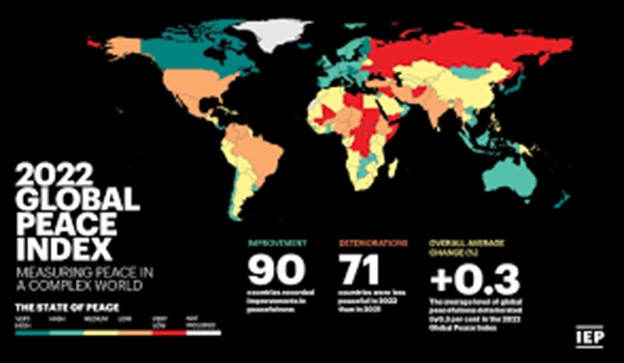 I checked this site as I thought about travel to Africa, and other parts of the world I plan to visit. The TOP TEN SAFEST COUNTRIES in the world in 2022, according to this study, are:
I checked this site as I thought about travel to Africa, and other parts of the world I plan to visit. The TOP TEN SAFEST COUNTRIES in the world in 2022, according to this study, are:
- Iceland. 2. New Zealand. 3. Ireland. 4. Denmark. 5. Austria. 6. Portugal. 7. Slovenia. 8. Czech Republic. 9. Singapore. 10. Japan
 Iceland has held the position of “Most Peaceful Country” since 2008. Afghanistan is the least peaceful country for the fifth consecutive year, at the bottom of the list of 163 countries in the world. Yemen, Syria, Russia and South Sudan complete the bottom five. Noted this year:
Iceland has held the position of “Most Peaceful Country” since 2008. Afghanistan is the least peaceful country for the fifth consecutive year, at the bottom of the list of 163 countries in the world. Yemen, Syria, Russia and South Sudan complete the bottom five. Noted this year:
- Deaths from external conflict recorded a sharp deterioration driven by the Russian invasion of Ukraine.
- The rise in costs has increased food insecurity and political instability globally, with Africa, South Asia and the Middle East under greatest threat.
- The political terror scale, political insecurity, neighboring country relations, refugees and IDPs reached their worst score since the inception of the GPI.
Seven of the ten countries at the TOP of the Global Peace Index are in Europe.
The safety rankings of the countries we’ll be visiting and returning to:
- Iceland – #1
- Tanzania – #86
- Kenya – #120
- United States – #129
This photo was taken February 7, 2022 with a zoom lens from my bedroom window, as a Memorial Service was conducted in the City Park behind my house. A young man was killed in a shoot-out near the Park a few weeks earlier. A large crowd attended the Memorial Service, lighting candles and offering prayers for better community relations in Little Rock. I have lost count of the shootings in Little Rock this year alone.
I too pray for peace – in my community, my country, and my world.
» posted on Sunday, August 7th, 2022 by Linda Lou Burton
Checking In On Reality
Originally published August 6, 2020 by Linda Lou Burton posting from Little Rock, Arkansas – A reality check today, before I talk about my wonderful visit to Abu Dhabi.
It is clear, I hope, that all my travel posts are strictly imaginary. Imaginary, however, only due to COVID-19. This was to be a full-fledged Round The World trip celebrating 81 years of life,  and I had booked all the hotels I mention in my posts, and selected all my flights. I carefully routed myself for the shortest in-air time possible, over the least amount of water. I’m not good at sitting in a tube with a belt buckled over my lap for more than six hours! So I meticulously planned.
and I had booked all the hotels I mention in my posts, and selected all my flights. I carefully routed myself for the shortest in-air time possible, over the least amount of water. I’m not good at sitting in a tube with a belt buckled over my lap for more than six hours! So I meticulously planned.
But “life happens while you’re making other plans” fell true this March, when world travel was shut down in a hurry. So I consoled myself by declaring I’d imagine the trip, and think myself there. I renamed it the Now Defunct Imaginary Round The World (NDI RTW), and I started writing. After Abu Dhabi I go to Cairo, and cruise the Nile; then Reykjavik, Iceland, the northernmost capital city in the world! Get it? Wellington, and Reykjavik? My two high-school-graduate grandchildren are (were) meeting me there, and then a flight to Washington, DC together for a rousing end to an RTW, and finally a grand celebration back in Little Rock.
As of this week, the Center for Disease Control reports 4,678,610 cases of COVID-19 in the United States.
The World Health Organization reports 18,614,177 cases of COVID-19 worldwide.
I checked on current travel restrictions in the countries on my RTW, info from the US State Department, the agencies within countries, and the airlines. Here goes:
New Zealand
The New Zealand borders are closed for all but critical travel — protecting public health in New Zealand is paramount. The travel ban applies to all arrivals into New Zealand whether it is by air or sea. To help stop the spread of COVID-19, people who do arrive in New Zealand are required to undergo either managed isolation or quarantine for at least 14 days. https://covid19.govt.nz/travel-and-the-border/border-restrictions/#border-entry-restrictions
Australia
Australia’s borders are closed. Only Australian citizens, residents and immediate family members can travel to Australia. Australian Border Force liaison officers will work with airlines at overseas airports to identify those who should not board flights to Australia. https://www.health.gov.au/news/health-alerts/novel-coronavirus-2019-ncov-health-alert/coronavirus-covid-19-restrictions/coronavirus-covid-19-advice-for-international-travellers#travel-into-australia
Thailand
Updated 01st of August 2020: The Civil Aviation Authority in Thailand decided to extend the restrictions concerning commercial flights arriving in Thailand (with some exceptions) until 31th of August 2020. https://www.thaiairways.com/en_SE/news/news_announcement/news_detail/coronavirus.page
United Arab Emirates
The UAE government announced travelers must have a negative COVID-19 test result before flying to the country. The National Crisis and Emergency Management Authority (NCEMA) said all travelers, including Emiratis, residents, tourists, and transit passengers, must have a negative COVID-19 PCR (nasal swab) test result within 96 hours in order to board commercial flights to the UAE. NCEMA said the new system will be in place August 1. However, there are reports Etihad and Emirates airlines began implementing this new regulation on July 24. https://ae.usembassy.gov/u-s-citizen-services/covid-19-information/
Egypt
As of the evening of August 5, there were 94,875 confirmed cases of Covid-19 and 4,930 deaths in Egypt. Egypt is implementing 14-day quarantine periods and other preventative measures in all cases. https://eg.usembassy.gov/u-s-citizen-services/covid-19-information/
Iceland
As of 31 July, passengers arriving in Iceland who intend to stay in Iceland for 10 days or more have to undergo 2 COVID tests. The first is at the border on arrival and the second by the primary healthcare service 4-6 days later. In between the two tests, special precautions need to be taken. https://www.icelandair.com/support/covid-19/faq
Washington DC
As of July 24, if you are out in DC, you are required to wear a mask, with a few exceptions for vigorous exercise or while you’re actively eating or drinking. A self-quarantine of 14 days is required after participating in non-essential travel to/from high-risk areas when returning or traveling to Washington, DC, beginning July 27. The list of high-risk states included in the Mayor’s order are below and are in effect until Monday, Aug. 10.
- Arkansas
- Arizona
- Alabama
- California
- Delaware
- Florida
- Georgia
- Idaho
- Iowa
- Kansas
- Louisiana
- Mississippi
- Missouri
- Montana
- Nebraska
- Nevada
- New Mexico
- North Carolina
- North Dakota
- Ohio
- Oklahoma
- South Carolina
- Tennessee
- Texas
- Utah
- Washington
- Wisconsin
There you have it.
» posted on Thursday, July 21st, 2022 by Linda Lou Burton
From the Queen Bee to the MMP
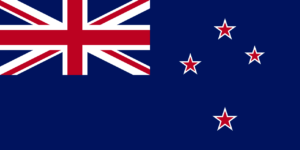 Originally Published July 23, 2020 by Linda Lou Burton posting about Wellington, New Zealand from Little Rock, Arkansas – This is a major election year in the United States, with politics running hot and uncertainty running high under the shadow of COVID-19. As I’ve studied the island nation of New Zealand these last few days, I found that 2020 is an election year there too – they do it every three years. So I dug in to see how it’s going.
Originally Published July 23, 2020 by Linda Lou Burton posting about Wellington, New Zealand from Little Rock, Arkansas – This is a major election year in the United States, with politics running hot and uncertainty running high under the shadow of COVID-19. As I’ve studied the island nation of New Zealand these last few days, I found that 2020 is an election year there too – they do it every three years. So I dug in to see how it’s going.
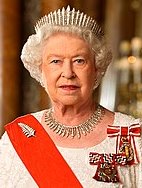 I learned that New Zealand ranks high in civic participation, with almost 80% voter turnout in recent elections. Considered one of the world’s most stable and well-governed states, the country is a constitutional monarchy with a parliamentary democracy, and Elizabeth II is the queen of New Zealand and therefore head of state.
I learned that New Zealand ranks high in civic participation, with almost 80% voter turnout in recent elections. Considered one of the world’s most stable and well-governed states, the country is a constitutional monarchy with a parliamentary democracy, and Elizabeth II is the queen of New Zealand and therefore head of state.
Now hang on and follow this trail, remember that the Beehive in Wellington is comparable to the US Capitol in Washington, DC. Here goes:
Head of State
As Head of State of New Zealand, the Queen has a range of royal powers which include signing bills into law, formally appointing governments and Ministers, appointing judges, and opening and dissolving Parliament.
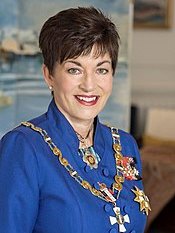 Her representative, the Governor-General, currently Dame Patsy Reddy (2016), has full authority to act on the Queen’s behalf when the Queen is not physically present in New Zealand. Make note: The Queen has visited New Zealand on only ten occasions since 1953, the last in 2002.The Constitution Act states that the Queen, or the Governor-General, can only exercise any of the royal powers with the advice and consent of the Government of the New Zealand.
Her representative, the Governor-General, currently Dame Patsy Reddy (2016), has full authority to act on the Queen’s behalf when the Queen is not physically present in New Zealand. Make note: The Queen has visited New Zealand on only ten occasions since 1953, the last in 2002.The Constitution Act states that the Queen, or the Governor-General, can only exercise any of the royal powers with the advice and consent of the Government of the New Zealand.
Head of Government
The New Zealand Government is the central government through which governing authority operates, within the framework “the Queen reigns, but the government rules, so long as it has the support of the House of Representatives.”
Parliament consists of the Sovereign, (the Head of State) and the House of Representatives, (the elected legislature.) Parliament has 120 seats.
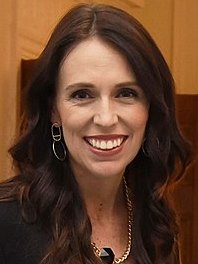 The Prime Minister is New Zealand’s head of government, with the authority to lead the government while answering to Parliament. The Prime Minister is formally appointed by the Governor General, based on agreements between parties and internal leadership votes. Jacinda Ardern (2017) serves as the current Prime Minister, an elected member of the Labour Party – the largest party in the coalition Government formed after the 2017 elections.
The Prime Minister is New Zealand’s head of government, with the authority to lead the government while answering to Parliament. The Prime Minister is formally appointed by the Governor General, based on agreements between parties and internal leadership votes. Jacinda Ardern (2017) serves as the current Prime Minister, an elected member of the Labour Party – the largest party in the coalition Government formed after the 2017 elections.
Political Parties in New Zealand
There are five parliamentary parties in the 52nd Parliament.
- The ACT Party has one member of Parliament. Read more
- The Green Party of Aotearoa / New Zealand has 8 members of Parliament, all from the party list. Read more
- The New Zealand Labour Party has 46 members of Parliament, 17 elected from the party list and 29 electorate seats. Read more
- The New Zealand National Party has 54 members of Parliament, 15 elected from the party list and 39 electorate seats. The National Party is in Opposition. Read more
- The New Zealand First Party has 9 members of Parliament, all from the party list. Read more
The MMP
MMP is the voting system in New Zealand. It stands for Mixed Member Proportional. A registered voter gets two votes under MMP:
- A party vote for a political party to help choose how many seats in Parliament each party gets.
- An electorate vote for a candidate from the area the voter lives in.
 Every candidate who wins an electorate gets a seat in Parliament. They are called Electorate MPs. The remaining seats are filled from party lists. Every party has a list of candidates ranked in the order the party wants those candidates to be elected to Parliament. Candidates elected from a party list are called List MPs.
Every candidate who wins an electorate gets a seat in Parliament. They are called Electorate MPs. The remaining seats are filled from party lists. Every party has a list of candidates ranked in the order the party wants those candidates to be elected to Parliament. Candidates elected from a party list are called List MPs.
Usually no party gets enough votes to govern alone. Parties often need to come to an agreement with other parties to form a government or pass legislation. Some types of possible agreements are:
- coalitions — when two or more parties join together to form a government
- confidence and supply agreements — when one party agrees to support another on certain issues and laws that are voted on in Parliament.
Who Can Vote
You are eligible to enroll and vote if you are 18 years or older, a New Zealand citizen or permanent resident, and you’ve lived in New Zealand continuously for 12 months or more at some time in your life. If you’re of Māori descent and enrolling for the first time, you may enroll on the general roll or the Māori roll to choose which electorate you vote in.
If you’re in New Zealand, you’ll be able to vote from Saturday 5 September to 7pm on election day, Saturday 19 September. Voting places will open across New Zealand, so everyone has a chance to vote. You can vote from overseas from Wednesday 2 September.
At the 2020 General Election, you can vote for the parties and candidates you want to represent you in Parliament, and you can vote in two referendums: whether the recreational use of cannabis should become legal, and whether the End of Life Choice Act 2019 should come into force, giving people with a terminal illness the option of requesting assisted dying.
Making It Safe To Vote
Keeping everyone safe is essential. Voting will open 2 days earlier than usual, and there will be more voting places to reduce queues. Vote locally and bring your own pen if you can. Hand sanitizer will be provided at voting places, and there will be space for physical distancing. If you need to stay home, you’ll have other ways of voting including voting by post.
Preliminary election results will be released from 7pm on 19 September; official results for the general election and referendums will be released on Friday 9 October.
This information was taken from the following websites, an impressive and useful array of tools to keep New Zealanders informed:
- The Beehive, Official website of the New Zealand Government, https://www.beehive.govt.nz/
- New Zealand Parliament, business, calendar, electorates, visit and learn, https://www.parliament.nz/
- Political Parties in New Zealand, https://www.parliament.nz/en/mps-and-electorates/political-parties/
- New Zealand Government, the system, how it works, how to engage, https://www.govt.nz/
- New Zealand Electoral Commission, complete voting information with a special page devoted to COVID-19 concerns: https://vote.nz/
» posted on Sunday, July 17th, 2022 by Linda Lou Burton
Topsy Turvy
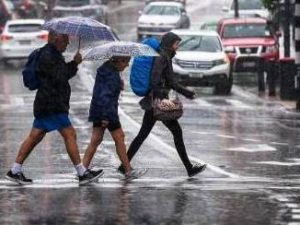 Originally Published July 20, 2020 by Linda Lou Burton posting about Wellington, New Zealand from Little Rock, Arkansas – I don’t know how the jet-setters do it. Crossing the International Dateline east to west on my now defunct RTW Capital City Quest, I’d lose an entire day. Crossing the Equator, I’d change hemispheres, and therefore, seasons. It may feel like 106 in Little Rock today, but it’s winter in Wellington! Though winter there isn’t too bad – 54 degrees with a breeze today; 100% chance of rain.
Originally Published July 20, 2020 by Linda Lou Burton posting about Wellington, New Zealand from Little Rock, Arkansas – I don’t know how the jet-setters do it. Crossing the International Dateline east to west on my now defunct RTW Capital City Quest, I’d lose an entire day. Crossing the Equator, I’d change hemispheres, and therefore, seasons. It may feel like 106 in Little Rock today, but it’s winter in Wellington! Though winter there isn’t too bad – 54 degrees with a breeze today; 100% chance of rain.
Pago Pago, American Samoa is the southernmost US capital city, but Wellington, New Zealand is the southernmost capital city in the entire world. It is also the most remote capital city, the farthest from any other capital. Now that’s a noteworthy distinction, and puts it at the top of my “Capital City Superlatives” list.
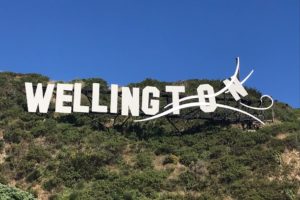 Here are some basics about Wellington: its urban land area is 171 sq miles, the metro area 536, with an elevation of 0 at the waterfront and 1,624 in the hills. It isn’t New Zealand’s largest city, population-wise, Auckland is. Wellington’s urban population is 215,400, with a metro population of 424,200. That’s comparable to the US capital cities of Little Rock, say, or Madison, Wisconsin. The population breakdown shows about 72% of Wellingtonians are of European ethnicity; 15% Asian, 14% Maori, 10% various Pacific peoples, and the remainder Middle Eastern, Latin, African, and other.
Here are some basics about Wellington: its urban land area is 171 sq miles, the metro area 536, with an elevation of 0 at the waterfront and 1,624 in the hills. It isn’t New Zealand’s largest city, population-wise, Auckland is. Wellington’s urban population is 215,400, with a metro population of 424,200. That’s comparable to the US capital cities of Little Rock, say, or Madison, Wisconsin. The population breakdown shows about 72% of Wellingtonians are of European ethnicity; 15% Asian, 14% Maori, 10% various Pacific peoples, and the remainder Middle Eastern, Latin, African, and other.
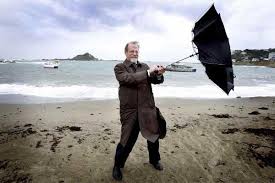 Wellington has been capital of New Zealand since 1865, and sits at the south end of the north island, between Cook Strait and the Remutaka Range. Because of its location in the Roaring Forties – strong westerly winds caused by air being displaced from the Equator towards the South Pole – it is considered the world’s windiest city, giving it the nickname Windy Welly.
Wellington has been capital of New Zealand since 1865, and sits at the south end of the north island, between Cook Strait and the Remutaka Range. Because of its location in the Roaring Forties – strong westerly winds caused by air being displaced from the Equator towards the South Pole – it is considered the world’s windiest city, giving it the nickname Windy Welly.
It has a few other catchy names too – in 2016 the Mercer Quality of Living Survey ranked Wellington 12th Most Livable City in the World; in 2018 Deutsche Bank ranked it first in the world for both livability and non-pollution (those winds help, I suppose!). And Lonely Planet dubbed it the Coolest Little Capital in the World, pretty snazzy, I’d say.
But why am I talking? Those who promote New Zealand for a living have the best websites I’ve ever seen, so let’s read up, no mask needed for that. Straight from the horse’s mouth, https://www.newzealand.com/us/wellington/ will guide you not only in Wellington, but over all of New Zealand, with focus on any city of your choice; https://www.wellingtonnz.com/ tells everything you’ll want to know about the capital city with gorgeous pictures and fast-paced videos.
Here are a few things I shamelessly lifted from their sites, hoping to promote the area, and wishing I were there.
Things To Do in Wellington
Surrounded by nature and fueled by creative energy, Wellington is a compact city with a powerful mix of culture, history, nature and cuisine. Fuel your visit with strong coffee and world-class craft beer – Wellingtonians are masters of casual dining, with plenty of great restaurants, night markets and food trucks.
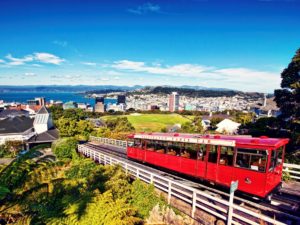 Relax at Oriental Bay, Wellington’s golden-sand inner-city beach and delve into the many museums, art galleries and theatre shows that make up the city’s pulsing cultural scene. If you’re into the outdoors, Wellington has action-packed adventure activities like mountain biking and sea-water kayaking, as well as beautiful walks around the harbour and surrounding hills. Ride the cable car up the hill to Kelburn for amazing views over the city. On the waterfront itself you’ll find New Zealand’s national museum, Te Papa, meaning ‘our place,’ one of the best interactive museums in the world.
Relax at Oriental Bay, Wellington’s golden-sand inner-city beach and delve into the many museums, art galleries and theatre shows that make up the city’s pulsing cultural scene. If you’re into the outdoors, Wellington has action-packed adventure activities like mountain biking and sea-water kayaking, as well as beautiful walks around the harbour and surrounding hills. Ride the cable car up the hill to Kelburn for amazing views over the city. On the waterfront itself you’ll find New Zealand’s national museum, Te Papa, meaning ‘our place,’ one of the best interactive museums in the world.
Or if you just want a quickie two-minute tour, watch this video!
https://www.youtube.com/watch?v=72stLrXYmHo
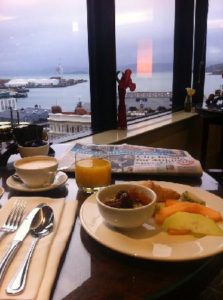 As for me and my make-believe COVID-19-free RTW journey, I got up at 7 AM on Saturday July 18, flew from Pago Pago to Apia to Auckland to Wellington in a sleepless mad rush of plane changes and time changes and weather changes and culture changes, and arrived at my hotel at 9 AM Wellington time on Monday July 20. In true jet-setter style, I’m booked in an executive suite at the Intercontinental, 14th floor, waterfront view, where I hunker down, gaze across the bay, and try to figure out which end is up.
As for me and my make-believe COVID-19-free RTW journey, I got up at 7 AM on Saturday July 18, flew from Pago Pago to Apia to Auckland to Wellington in a sleepless mad rush of plane changes and time changes and weather changes and culture changes, and arrived at my hotel at 9 AM Wellington time on Monday July 20. In true jet-setter style, I’m booked in an executive suite at the Intercontinental, 14th floor, waterfront view, where I hunker down, gaze across the bay, and try to figure out which end is up.
Tomorrow I’ll be right side up again.
» posted on Friday, July 15th, 2022 by Linda Lou Burton
One Samoa Two Samoa
Originally Published July 18, 2020 by Linda Lou Burton posting about the Samoan Islands from Little Rock, Arkansas – Divide the thousands of islands in the Pacific Ocean into three major cultural areas – Micronesia, Melanesia, and Polynesia. Now let’s hone in on one, the part of my planned RTW journey – Polynesia. What is Polynesia, anyhow? Geologically speaking, it is more than a thousand islands in the mid and southern part of the Pacific. Most Polynesian islands and archipelagos, including the Hawaiian and Samoan islands, are volcanic, built by hotspots (remember our Hot Spot post of July 15). But some are the unsubmerged portions of a largely sunken continent. New Zealand, the largest island in Polynesia, is one of those.
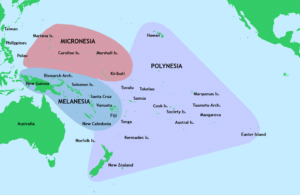 Culturally, these Polynesian islands share similarities in language and belief systems, and not surprisingly, a strong tradition of sailing. Politically, they differ widely. Within the core island groups, there are countries, collectivities, dependencies, self-governing states, a US state, four territories and four independent nations! My RTW was to include stops in the US state of Hawaii, the US territory of American Samoa, and the independent nations of Samoa, and New Zealand.
Culturally, these Polynesian islands share similarities in language and belief systems, and not surprisingly, a strong tradition of sailing. Politically, they differ widely. Within the core island groups, there are countries, collectivities, dependencies, self-governing states, a US state, four territories and four independent nations! My RTW was to include stops in the US state of Hawaii, the US territory of American Samoa, and the independent nations of Samoa, and New Zealand.
Today’s focus: American Samoa and Samoa
American Samoa
- Capital: Pago Pago
- Land Area: 77 sq miles
- Population: 55,212
- Currency: US Dollar
- Language: English, Samoan
- Religion: 98% Christian
- Airport: Pago Pago International, service to Honolulu, inter-island
Samoa
- Capital: Apia
- Land Area: 1,097 sq miles
- Population: 195,843
- Currency: Tala
- Language: Samoan, English
- Religion: Christian Official
- Airport: Faleolo International Airport, service to Australia, New Zealand, Honolulu, inter-island
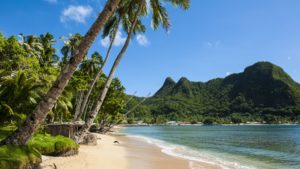 American Samoa, capital city Pago Pago, has been a US territory since 1900 and the end of the Second Samoan Civil War, when the Samoan Islands were divided. For 51 years the US Navy controlled the territory. Today American Samoa is locally self-governing under a 1967 constitution. In 1977 the first governor was elected; in 1981 the first non-voting member of Congress. People born in American Samoa are US nationals, but not citizens. It is the only US Territory where citizenship is not granted automatically at birth.
American Samoa, capital city Pago Pago, has been a US territory since 1900 and the end of the Second Samoan Civil War, when the Samoan Islands were divided. For 51 years the US Navy controlled the territory. Today American Samoa is locally self-governing under a 1967 constitution. In 1977 the first governor was elected; in 1981 the first non-voting member of Congress. People born in American Samoa are US nationals, but not citizens. It is the only US Territory where citizenship is not granted automatically at birth.
 Samoa, capital city Apia, is a unitary parliamentary democracy, and a member of the Commonwealth of Nations and the United Nations. It was governed by New Zealand until its independence in 1962, and was the first small-island country in the Pacific to become independent.
Samoa, capital city Apia, is a unitary parliamentary democracy, and a member of the Commonwealth of Nations and the United Nations. It was governed by New Zealand until its independence in 1962, and was the first small-island country in the Pacific to become independent.
As a people, Samoans share a common language, a warm, generous spirit, and a 3,000-year-old cultural code. Fa’a Samoa, the Samoan Way, emphasizes loyalty to family, respect for one’s elders, and a commitment to serving the community, which is considered all-important. But even though the capital cities of Pago Pago and Apia are only 123 miles apart, and the landscapes share the same gorgeous tropical blues and greens, the two Samoas have gradually shifted their connections towards different sides of the Pacific.
In 2009, the Samoan government changed the rule of the road from right to left, in common with Australia and New Zealand, home to large numbers of Samoans. In 2011, Samoa further connected to those countries by moving the International Dateline. At the end of December that year, it simply jumped forward one day. Instead of being 21 hours behind Sydney, now it is three hours ahead, allowing for easier business connections with Australia and New Zealand. American Samoa’s business connections are more closely tied to Hawaii, and the US mainland, and the impact of US culture is evident there.
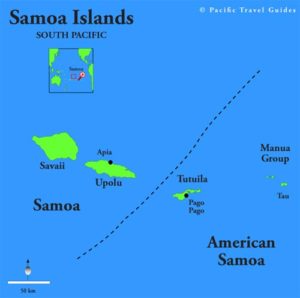 The dateline change means Samoan nationals no longer share the same day with their friends and families in American Samoa. But they can share Christmas dinner on two separate Christmas days! Because of that dateline draw, American Samoa is where a day officially ENDS, and Samoa where a day officially BEGINS.
The dateline change means Samoan nationals no longer share the same day with their friends and families in American Samoa. But they can share Christmas dinner on two separate Christmas days! Because of that dateline draw, American Samoa is where a day officially ENDS, and Samoa where a day officially BEGINS.
More about that in tomorrow’s post, when I would actually LOSE a day of my life!
» posted on Thursday, July 14th, 2022 by Linda Lou Burton
You Must Remember This
Originally Published July 17, 2020 by Linda Lou Burton posting about American Samoa from Little Rock, Arkansas – On June 23, 2012, I was at the Polynesian Cultural Center on the island of Oahu, Hawaii, with my granddaughter, who was 10. Here’s how it went:
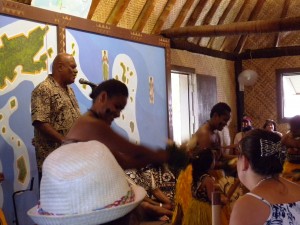 They found a place for Kayla and me on the back row of the jam-packed Fiji hut, and there we sat, bamboo sticks in hand, learning to chant and sing Fiji style. And, learning how to remember. The presentation at the Fiji settlement in the Polynesian Cultural Center was titled “History through Chants & Dance” and we’d just been taught how, as a group, to beat out rhythms, “one-two one-two-three” then “one-two-three-four” fast and slow, stop; then a call to us, “moo-oo” then our response “mai-ii” and repeat; somehow the roomful of us managed to do this together; and somehow, the feel of it began to stick in our memories.
They found a place for Kayla and me on the back row of the jam-packed Fiji hut, and there we sat, bamboo sticks in hand, learning to chant and sing Fiji style. And, learning how to remember. The presentation at the Fiji settlement in the Polynesian Cultural Center was titled “History through Chants & Dance” and we’d just been taught how, as a group, to beat out rhythms, “one-two one-two-three” then “one-two-three-four” fast and slow, stop; then a call to us, “moo-oo” then our response “mai-ii” and repeat; somehow the roomful of us managed to do this together; and somehow, the feel of it began to stick in our memories.
Our narrator explained the value of learning by chanting: “we had no written language until recent times, so stories and our history were passed down orally. Family is very important in our culture, and children are taught from the beginning about their ancestors,” he continued. “My 10-year old son can recite our family genealogy for 17 generations.”
Kayla and I exchanged glances, startled. Seventeen generations?
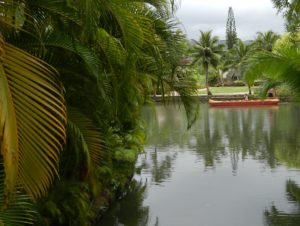 The Polynesian Cultural Center – rated the top tourist attraction in Hawaii, is a non-profit organization operated by the LDS church. It is a family place with pleasant walkways and waterways meandering through 42 acres of Polynesian “settlements” representing Samoa, New Zealand (Aotearoa-Maori), Fiji, Hawaii, Tahiti, Tonga, and Easter Island (Rapa Nui). Its purpose is simply to preserve the culture of Polynesia. It’s all about remembering.
The Polynesian Cultural Center – rated the top tourist attraction in Hawaii, is a non-profit organization operated by the LDS church. It is a family place with pleasant walkways and waterways meandering through 42 acres of Polynesian “settlements” representing Samoa, New Zealand (Aotearoa-Maori), Fiji, Hawaii, Tahiti, Tonga, and Easter Island (Rapa Nui). Its purpose is simply to preserve the culture of Polynesia. It’s all about remembering.
As I planned my 2020 RTW stops in Hawaii, American Samoa, and New Zealand, I thought back to that day, and how little I really know of Polynesian culture. I’d planned to remedy that somewhat today as I explored the National Park of American Samoa, which of course is closed due to COVID-19, but I’ll share some facts from their website, https://www.nps.gov/npsa
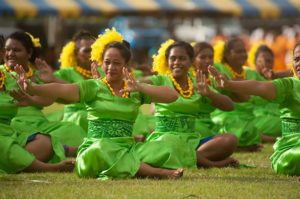 The Samoan culture is Polynesia’s oldest. We believe the first people of the Samoan Islands came by sea from southwest Asia some 3,000 years ago. Over the centuries, distinct cultural traits emerged that we now call fa’asamoa (fah-ah-SAH-mo-ah). From Samoa seafaring explorers and settlers journeyed to other Polynesian island groups hundreds of miles away.
The Samoan culture is Polynesia’s oldest. We believe the first people of the Samoan Islands came by sea from southwest Asia some 3,000 years ago. Over the centuries, distinct cultural traits emerged that we now call fa’asamoa (fah-ah-SAH-mo-ah). From Samoa seafaring explorers and settlers journeyed to other Polynesian island groups hundreds of miles away.
Follow the Fa’a Samoa —The Samoan Way
Alofa and Afio Mai! — Hello and Welcome — with some tips for pleasant visits to the villages of the islands.
- Always ask villagers for permission before taking photographs, using the beach, or engaging in other activities, however unobtrusive your actions may seem. Permission will almost certainly be granted.
- Sunday is the day for church, rest, and especially for quiet around the villages. Activities that are acceptable on other days, such as swimming, may not be permitted on Sunday.
- In a traditional home, called a fale (fah-LAY), sit down on the floor before talking, eating, or drinking. Cross your legs or pull a mat over them; it is impolite to stretch out your legs uncovered.
- Do not eat or drink while walking through a village.
- Each evening around dusk, villagers observe a time for prayers called Sā. If you are entering a village during Sā, stop and wait quietly until Sā ends. You may even be invited to join in a family prayer. It is not necessary to stop for Sā on the main roads.
- It is considered an honor to be asked to share ‘ava (a local drink made from the root of the pepper plant). To show respect, spill a few drops on the ground or mat in front of you, then raise your cup and say manuia (mahn-WE-ah) before drinking.
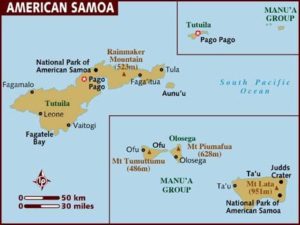 The ONLY US National Park south of the equator, the National Park of American Samoa’s 13,500 acres are distributed across three islands: Tutuila, Ofu, and Ta‘ū. Its purpose is to preserve and protect coral reefs, tropical rainforests, fruit bats, and most importantly, Samoan culture. Part of the US National Park System since October 31, 1988, it is unusual in that the NPS does not own the Park lands, but entered into a 50-year lease with Samoan village councils.
The ONLY US National Park south of the equator, the National Park of American Samoa’s 13,500 acres are distributed across three islands: Tutuila, Ofu, and Ta‘ū. Its purpose is to preserve and protect coral reefs, tropical rainforests, fruit bats, and most importantly, Samoan culture. Part of the US National Park System since October 31, 1988, it is unusual in that the NPS does not own the Park lands, but entered into a 50-year lease with Samoan village councils.
Twenty-nine states have national parks, as do the territories of the US Virgin Islands, and American Samoa. There are currently 62 parks in system, with this mission: “to preserve unimpaired the natural and cultural resources and values…for the enjoyment, education, and inspiration of this and future generations.”
It’s all about remembering.
Pass It Forward https://capitalcitiesusa.org/?p=2365
Want Me To Jump? https://capitalcitiesusa.org/?p=2383
» posted on Thursday, August 20th, 2020 by Linda Lou Burton
Voting, and the Virus
Linda Lou Burton posting from Little Rock, Arkansas – As of August 20, the World Health Organization reports 22,536,278 cases of COVID-19 in the world. Of that, 5,511,793 cases are in the United States, a number which amounts to one quarter, that is 25% of the worldwide total. In case you’re wondering, the population of the United States is 5% of the world population. Just saying.
I find it difficult to keep up with the current hoopla about “who is doing what when” with regard to decisions about managing a pandemic on local ground; and even more hoopla about “how to have a secure vote” with regard to the upcoming presidential election. So the recent announcement about New Zealand’s decision to postpone a national election due to an upsurge in COVID-19 cases really caught my eye.
Action in New Zealand
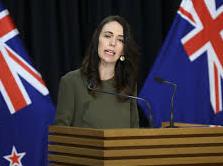 On Monday, August 17 Prime Minister Jacinda Ardern of New Zealand announced that the September national election would be delayed by four weeks as new virus cases spread across Auckland, making it difficult to campaign. Prime Minister Ardern, who has the sole authority to determine when people cast ballots, said she had consulted with all the major parties before delaying the vote, originally scheduled for September 19, to October 17. Ms Ardern called the decision a compromise that “provides sufficient time for parties to plan around the range of circumstances we could be campaigning under, for the electoral commission to prepare, and for voters to feel assured of a safe, accessible and critical election.”
On Monday, August 17 Prime Minister Jacinda Ardern of New Zealand announced that the September national election would be delayed by four weeks as new virus cases spread across Auckland, making it difficult to campaign. Prime Minister Ardern, who has the sole authority to determine when people cast ballots, said she had consulted with all the major parties before delaying the vote, originally scheduled for September 19, to October 17. Ms Ardern called the decision a compromise that “provides sufficient time for parties to plan around the range of circumstances we could be campaigning under, for the electoral commission to prepare, and for voters to feel assured of a safe, accessible and critical election.”
The shift keeps Election Day within the time frame allowed under the law — the latest possible date is November 21 — but it also highlights the national concern as a cluster of at least 58 new cases frustrates investigators, clears the streets of Auckland and suspends scheduled campaign events. Pressure on Ms Ardern and her Labour Party to change the date had been building over several days. A poll taken over the weekend showed that 60 percent of New Zealanders favored a delay. The leaders of other major parties also argued that the Level 3 lockdown in Auckland, the country’s largest city, prevented campaigning and would have made a free and fair election impossible on the original date.
I noted earlier, when on my NDI RTW visit to New Zealand, that their voting process is quite different from the US, where campaigning begins early and the media races to outdo itself by predicting, and announcing, results “before midnight.” I still recall my frustration in Seattle one year when I headed for the polls after work, only to hear “the winner declared” on the car radio. With our current Cell Phone Mentality, it’s a second-by-second race to get ahead of the game. I call it blather. Just saying.
From the New Zealand Electoral Commission webpage, I see today’s schedule for their 2020 General Election.
- Monday 17 August: Prime Minister announces new dates for the 2020 General Election
- Tuesday 18 August: Regulated period for election advertising expenses begins
- Sunday 6 September: Parliament dissolves
- Sunday 13 September: Writ Day – the Governor General formally directs us to hold the Election
- Thursday 17 September noon: Deadline for party secretaries to get their bulk nomination schedules and the party lists to us
- Friday 18 September noon: Deadline for electorate candidates to get their individual nomination forms to us
- Wednesday 30 September: Overseas voting starts
- Saturday 3 October: Advance voting starts
- Friday 16 October: Advance voting ends
- Friday 16 October midnight: The regulated period ends. All election and referendum advertising must end. Signs must be taken down by midnight.
- Saturday 17 October: Election day. Voters can vote from 9am to 7pm
- We’ll start releasing preliminary election results from 7pm on electionresults.govt.nz
- We won’t count referendum votes on election night
- Friday 30 October: We release the preliminary results for the referendums
- Friday 6 November: We declare the official results for the general election and referendums
- Thursday 12 November: Last day for the return of the writ
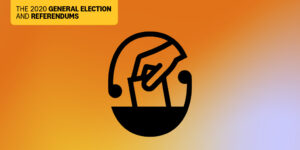 Easy peasy. Sit back and have a cup of tea. So, what will Ms Arden and the New Zealand government DO during this “delayed election” time? They will focus primarily on the virus. Health officials in New Zealand are scrambling to test thousands of workers at airports and other points of entry, along with quarantine facilities and a frozen food warehouse, to try to determine how the virus re-emerged last week.
Easy peasy. Sit back and have a cup of tea. So, what will Ms Arden and the New Zealand government DO during this “delayed election” time? They will focus primarily on the virus. Health officials in New Zealand are scrambling to test thousands of workers at airports and other points of entry, along with quarantine facilities and a frozen food warehouse, to try to determine how the virus re-emerged last week.
New Zealand’s election is far from the first to be postponed because of the pandemic. The International Foundation for Electoral Systems reports as of 08/20/2020 that 64 countries and eight territories have postponed a total of 109 election events due to COVID-19, ranging from local municipal elections to parliamentary and national events. The idea of delaying the US general election was floated by President Donald Trump, but it was shut down by members of Congress and his own party.
Everything you need to know about voting in New Zealand https://vote.nz/
Everything you need to know about voting in United States https://www.usa.gov/election
» posted on Wednesday, August 19th, 2020 by Linda Lou Burton
Women, And Politics
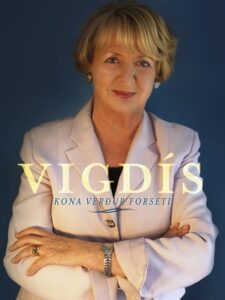 August 19, 2020, Linda Lou Burton posting from Little Rock, Arkansas – Iceland, a parliamentary representative democracy at the northern end of the globe, was the first country to have a female president, Vigdís Finnbogadóttir, elected in 1980. It also has the world’s first female and openly gay head of government, Jóhanna Sigurðardóttir, who was elected prime minister in 2009. Iceland has had a woman as either president or prime minister for 20 of the last 36 years. In the 2016 parliamentary election covering 63 seats, 30 women were elected.
August 19, 2020, Linda Lou Burton posting from Little Rock, Arkansas – Iceland, a parliamentary representative democracy at the northern end of the globe, was the first country to have a female president, Vigdís Finnbogadóttir, elected in 1980. It also has the world’s first female and openly gay head of government, Jóhanna Sigurðardóttir, who was elected prime minister in 2009. Iceland has had a woman as either president or prime minister for 20 of the last 36 years. In the 2016 parliamentary election covering 63 seats, 30 women were elected.
New Zealand, a constitutional monarchy with a parliamentary system of government at the southern end of the globe, was the first country in the world in which all the highest offices were occupied by women, between March 2005 and August 2006: the Sovereign Queen Elizabeth II, Governor-General Dame Silvia Cartwright, Prime Minister Helen Clark, Speaker of the House Margaret Wilson, and Chief Justice Dame Sian Elias. Currently Queen Elizabeth II continues as Head of State, Governor-General is Dame Patsy Reddy, Prime Minister is Jacinda Arden and Chief Justice is Dame Helen Winkelmann.
 There has never been a female President or Vice-President in the United States, a federal democratic republic. There has been one female major party presidential nominee in US history: Democrat Hillary Clinton in 2016. She was the first woman nominated for president by a major party, the first woman to participate in a presidential debate, and the first to carry a state in a general election. She won the popular vote in 2016, receiving nearly 66 million votes to Donald Trump’s 63 million.
There has never been a female President or Vice-President in the United States, a federal democratic republic. There has been one female major party presidential nominee in US history: Democrat Hillary Clinton in 2016. She was the first woman nominated for president by a major party, the first woman to participate in a presidential debate, and the first to carry a state in a general election. She won the popular vote in 2016, receiving nearly 66 million votes to Donald Trump’s 63 million.
There have been three female major party vice presidential nominees: Democrat Geraldine Ferraro in 1984, on the ticket with Walter Mondale; Republican Sarah Palin in 2008, on the ticket with John McCain; and Democrat Kamala Harris in 2020, on the ticket with Joe Biden.
Voting
Both Iceland and New Zealand rank in the World List of Voter Participation Top 10 , each averaging about 76% turnout. Others in the TOP 10 are Belgium, Sweden, Denmark, Australia, South Korea, Netherlands, Israel, and Finland. The United States ranks in the World List of Voter Participation Bottom 10, with 56% in the 2016 presidential election. Others in the BOTTOM 10 are Estonia, Luxembourg, Slovenia, Chile, Japan, Latvia, Poland, Mexico, and Switzerland.
August 26, 2020, marks the 100th anniversary of the passage of The Nineteenth Amendment, giving women the right to vote in the United States after 72 years of the largest civil rights movement in the history of the world.
THE WOMAN SUFFRAGE TIMELINE as complied in the LIZ LIBRARY is available for your review; read of the events that have transpired since 1776, when Abigail Adams first spoke up for “the ladies.” http://www.thelizlibrary.org/suffrage/
I offer only a few highlights regarding women’s efforts to be ALLOWED to vote.
1700s
 1776 Abigail Adams writes to her husband, John Adams, asking him to “remember the ladies” in the new code of laws. Adams replies the men will fight the “despotism of the petticoat.”
1776 Abigail Adams writes to her husband, John Adams, asking him to “remember the ladies” in the new code of laws. Adams replies the men will fight the “despotism of the petticoat.”- 1787 U.S. Constitutional Convention places voting qualifications in the hands of the states. Women in all states except New Jersey lose the right to vote.
1800s
- 1848 First Women’s Rights convention in Seneca Falls, New York. Equal suffrage proposed by Elizabeth Cady Stanton. After debate of so radical a notion, it is adopted.
- 1867 Fourteenth Amendment passes Congress, defining citizens as “male;” this is the first use of the word male in the Constitution. Kansas campaign for black and woman suffrage: both lose. Susan B. Anthony forms Equal Rights Association, working for universal suffrage. Suffrage Movement Divides Over Black v. Woman Suffrage.
- 1868 Fourteenth amendment ratified. Fifteenth Amendment passes Congress, giving the vote to black men. Women petition to be included but are turned down. Formation of New England Woman Suffrage Association. In New Jersey, 172 women attempt to vote; their ballots are ignored.
- 1870 Fifteenth Amendment ratified. The Grimke sisters and 42 other women attempt to vote in Massachusetts, their ballots are cast but ignored. Utah territory grants woman suffrage.
- 1878 Woman suffrage amendment first introduced in U.S. Congress.
- 1894 Despite 600,000 signatures, a petition for woman suffrage is ignored in New York.
1900s
- 1910 Washington (state) grants woman suffrage.
- 1911 California grants woman suffrage. In New York City, 3,000 march for suffrage.
- 1912 Teddy Roosevelt’s Progressive Party includes woman suffrage in their platform. Oregon, Arizona, and Kansas grant woman suffrage.
- 1913 Women’s Suffrage parade on the eve of Wilson’s inauguration is attacked by a mob. Alaskan Territory grants suffrage. Illinois grants municipal and presidential but not state suffrage to women.
- 1917 Beginning in January, NWP posts silent “Sentinels of Liberty” at the White House. In June, the arrests begin. Nearly 500 women are arrested, 168 women serve jail time, some are brutalized by their jailers. North Dakota, Indiana, Nebraska, and Michigan grant presidential suffrage; Arkansas grants primary suffrage. New York, South Dakota, and Oklahoma state constitutions grant suffrage.
- 1918 The jailed suffragists released from prison. Appellate court rules all the arrests were illegal. President Wilson declares support for suffrage. Suffrage Amendment passes U.S. House with exactly a two-thirds vote but loses by two votes in the Senate.
- 1919 In January, the NWP lights and guards a “Watchfire for Freedom.” It is maintained until the Suffrage Amendment passes U.S. Senate on June 4. The battle for ratification by at least 36 states begins.
And that battle ENDED in Tennessee on August 18, 1920, 100 years and 1 day ago. The story told by the guide when I toured the Nashville capitol was that young Harry T Burn from Niota gets credit for what happened that fateful day. At least, his mother does. The resolution had passed the Tennessee State Senate, but the vote in the House was close, in fact, on first vote it  did not pass. Harry’s mother, Febb Ensminger Burn, a prominent businesswoman, sent her son a note. After lunch, he changed his vote, then HID from the angry crowds, but that one vote was all it took. Tennessee was the 36th and final state needed for ratification and the 19th Amendment became law August 26, 1920.
did not pass. Harry’s mother, Febb Ensminger Burn, a prominent businesswoman, sent her son a note. After lunch, he changed his vote, then HID from the angry crowds, but that one vote was all it took. Tennessee was the 36th and final state needed for ratification and the 19th Amendment became law August 26, 1920.
Women, and Politics. Interesting.
» posted on Saturday, June 23rd, 2012 by Linda Lou Burton
Pass It Forward
 Linda Burton posting from Honolulu, Hawaii – “My 10-year-old son can recite our family genealogy for 17 generations back,” said our narrator. They’d found a place for Kayla and me on the back row of the jam-packed Fiji hut, and there we sat, bamboo sticks in hand, learning to chant and sing Fiji style. And, learning how to remember. The presentation at the Fiji settlement in the Polynesian Cultural Center was titled “History through Chants & Dance” and we’d just been taught how, as a group, to beat out rhythms, “one-two one-two-three” then “one-two-three-four” fast and slow, stop; then a call to us, “moo-oo” then our response “mai-ii” and repeat; somehow the roomful of us managed to do this together; and somehow, the feel of it began to stick in our memories. I know there’s a scientific explanation for what happens in the brain when rhythms and sounds take on a consistent pattern; but overall, it seemed to be the joy of it that took hold. Yet I was startled by that last remark. Seventeen generations? » read more
Linda Burton posting from Honolulu, Hawaii – “My 10-year-old son can recite our family genealogy for 17 generations back,” said our narrator. They’d found a place for Kayla and me on the back row of the jam-packed Fiji hut, and there we sat, bamboo sticks in hand, learning to chant and sing Fiji style. And, learning how to remember. The presentation at the Fiji settlement in the Polynesian Cultural Center was titled “History through Chants & Dance” and we’d just been taught how, as a group, to beat out rhythms, “one-two one-two-three” then “one-two-three-four” fast and slow, stop; then a call to us, “moo-oo” then our response “mai-ii” and repeat; somehow the roomful of us managed to do this together; and somehow, the feel of it began to stick in our memories. I know there’s a scientific explanation for what happens in the brain when rhythms and sounds take on a consistent pattern; but overall, it seemed to be the joy of it that took hold. Yet I was startled by that last remark. Seventeen generations? » read more

